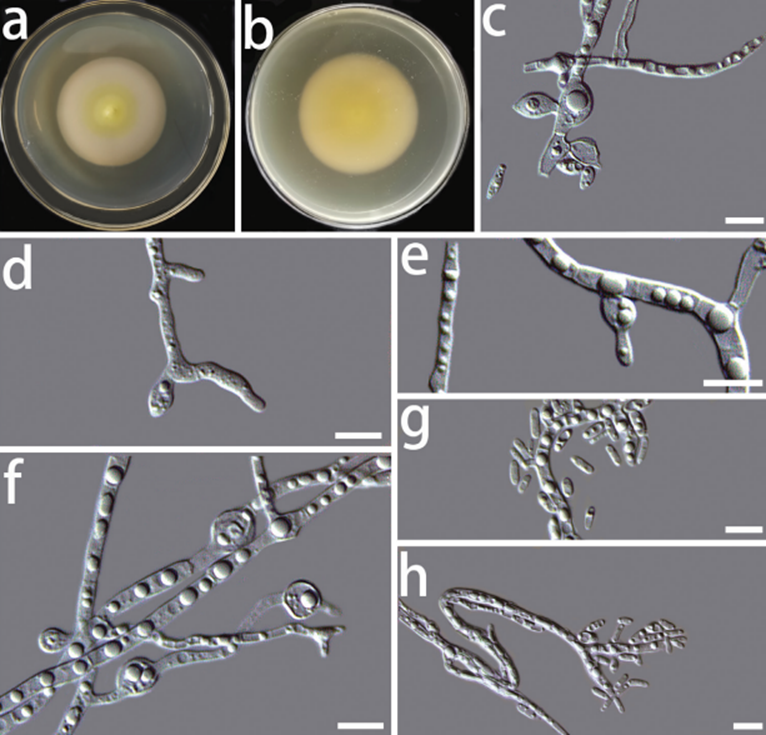 89
89
Coniochaeta sinensis H. L. Si & Y. M. Su, sp. nov.2021
MycoBank: 839388
Holotype. China, the Inner Mongolia Autonomous Region: Chifeng City, 44°13'46"N, 118°44'57"E, ca. 1500 m elev., isolated from the medulla of Ramalina sinensis, 11 Oct 2019, H. L. Si, CS-04 (HMAS 350269, holotype), ex-type culture CGMCC3.20306.
Morphological description :
Asexual morph: Colony on PDA after 8 d, hyphae hyaline, multi-guttulate, septate, smooth-walled, often hyphal strands consolidating to form bundles, conidiophores short or absent; conidiogenous cells hyaline, phialidic or oval in shape, single or in clusters on short lateral branches, measuring 2.8–7.1 × 1.1–3.7 μm (x– = 4.2 × 2.3 μm, n = 50) (Fig. 3c–e); conidia hyaline, one-celled, often oblong to ellipsoidal in shape, measuring 2.5–4.6 × 0.7–2.1 μm (x– = 3.3 × 1.2 μm, n = 50) (Fig. 3g, h); chlamydospore solitary or in short chains, hyaline, thick-walled, elongate ellipsoidal or almost globose in shape, measuring 3.7–6.6 × 2.5–5.4 μm (x– = 4.8 × 3.7 μm, n = 50) (Fig. 3f).
Sexual morph: unknown
Culture characteristics. The optimal temperature for growth is 30 °C. No growth was detected at 5 and 35 °C. Colonies on PDA after 8 d at 30 °C were yellow in the centre and white around the edges, circular, margin entire, flat, dense, partially immersed in the medium, the centre of the colony slightly bulging.
Habitat: isolated from the medulla of Ramalina sinensis
Distribution: China, the Inner Mongolia Autonomous Region
GenBank: lsu MW422265; its MW422269.
Notes:Coniochaeta sinensis sp. nov. clusters with C. vineae, C. fasciculata and C. mongoliae sp. nov. in our phylogenetic tree, constructed using the concatenated dataset, but the statistical support was insignificant. Amongst these species, C. vineae is only known in its sexual morph (Hyde et al. 2020). There are, however, significant morphological differences amongst C. sinensis sp. nov., C. fasciculata and C. mongoliae sp. nov. These are (1) the shapes and sizes of conidiogenous cells, (2) the shapes and sizes of conidia and (3) the shapes and sizes of chlamydospores. When compared to C. mongoliae sp. nov., C. sinensis sp. nov. has smaller conidiogenous cells and conidia. The conidia of C. sinensis sp. nov. are significantly smaller than those of C. fasciculata (Beyma 1939). Aside from that, the chlamydospores of C. sinensis sp. nov. are longer than those of C. mongoliae sp. nov.
Reference: [1] Limkaisang, S. , Kom-Un, S. , Furtado, E. L. , Liew, K. W. , Salleh, B. , & Sato, Y. , et al. (2005). Molecular phylogenetic and morphological analyses of oidium heveae, a powdery mildew of rubber tree. Mycoscience, 46(4), 220-226.

Morphological characters of Coniochaeta sinensis sp. nov. (HMAS 350269) a, b cultures on PDA from the surface and reverse c, d conidiogenous cells e conidiogenous cell that is producing conidia f chlamydospores g, h conidia. Scale bars: 10 μm

